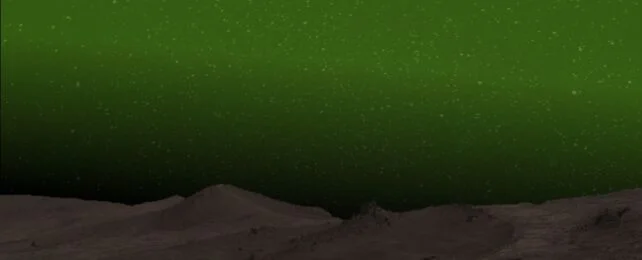
Martian Skies Light Up: NASA’s Perseverance Rover Captures First Visible Aurora on Mars!
For the first time, we have a ground-level view of an aurora on Mars! NASA's Perseverance rover has successfully observed and captured the first visible-light image of a Martian aurora, marking a monumental achievement in planetary science. The sky, typically reddish-brown due to dust, glowed a soft green across the Martian night sky in a breathtaking event on March 18, 2024. This discovery, detailed in a study published in Science Advances, provides invaluable insights into the interaction between the sun and the Martian atmosphere and offers a tantalizing glimpse of what future astronauts might witness on the Red Planet.
Previously, auroras on Mars had only been observed by satellites in ultraviolet wavelengths. Now, thanks to Perseverance, we have visual confirmation of a planet-wide aurora caused by energetic particles from a solar flare that impacted Mars. According to Elise Wright Knutsen, lead author of the study and researcher at the University of Oslo, the aurora was caused by charged particles interacting with oxygen in the Martian atmosphere. This occurred because Mars lacks a global magnetic field like Earth. Instead of being funneled towards the poles, the particles bombarded the entire planet, resulting in this unique global phenomenon.
While the aurora observed wasn't brilliant enough for human eyes to see directly, Knutsen suggests a more intense solar storm could produce a brighter aurora, easily visible with a camera, much like auroras on Earth. The rover used its SuperCam spectrometer to identify the green glow's wavelength and the Mastcam-Z camera to capture the visual.
"I’ve had this image in my mind for two years of a black horizon, like a mountain ridge, and then the glowing green sky behind it and that’s exactly what [the rover] saw,” said Elise Wright Knutsen. Her reaction displays the significance of this discovery.
This breakthrough not only gives us a stunning visual, but also unlocks new avenues for research. The ability to observe auroras from the Martian surface allows scientists to study changes in auroral brightness and links to solar storms. This aids in understanding magnetospheric, atmospheric, and space weather on Mars.
While Earth was spared from the solar storm that triggered this Martian light show, the event highlights the interconnectedness of our solar system. NASA’s MAVEN (Mars Atmosphere and Volatile EvolutioN) mission also confirmed SEP auroras in ultraviolet light from orbit.
What does this mean for future Martian explorers? As Katie Stack Morgan, acting project scientist for Perseverance at NASA’s Jet Propulsion Laboratory, states, "A better understanding of auroras and the conditions around Mars that lead to their formation are especially important as we prepare to send human explorers there safely."
The Red Planet continues to surprise us with its wonders. What other secrets does Mars hold, and what other celestial events await discovery by our robotic explorers? Share your thoughts and predictions in the comments below!